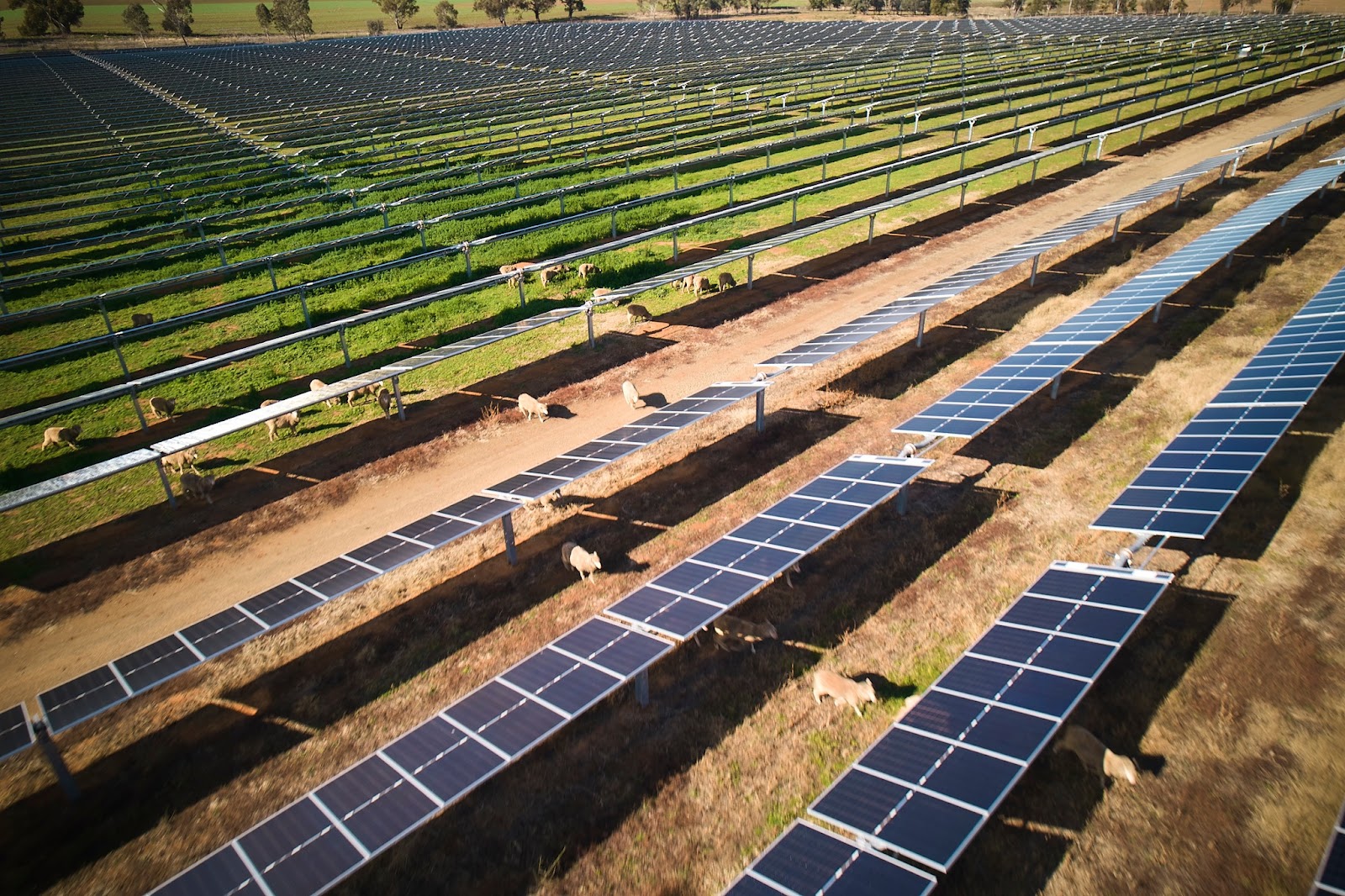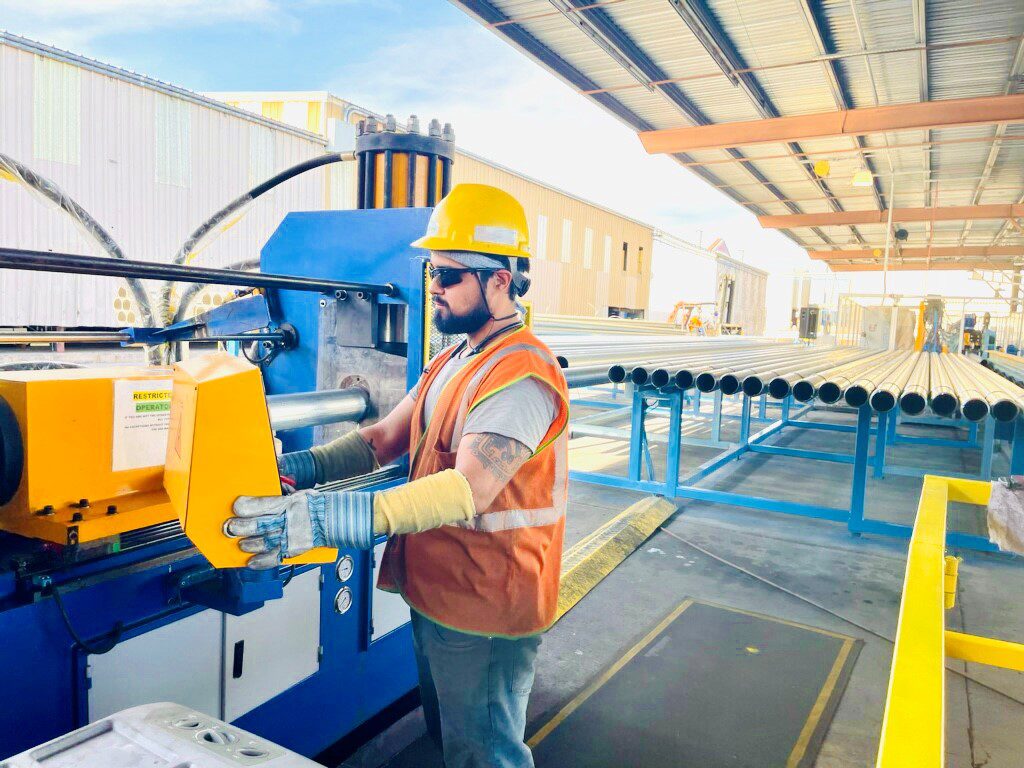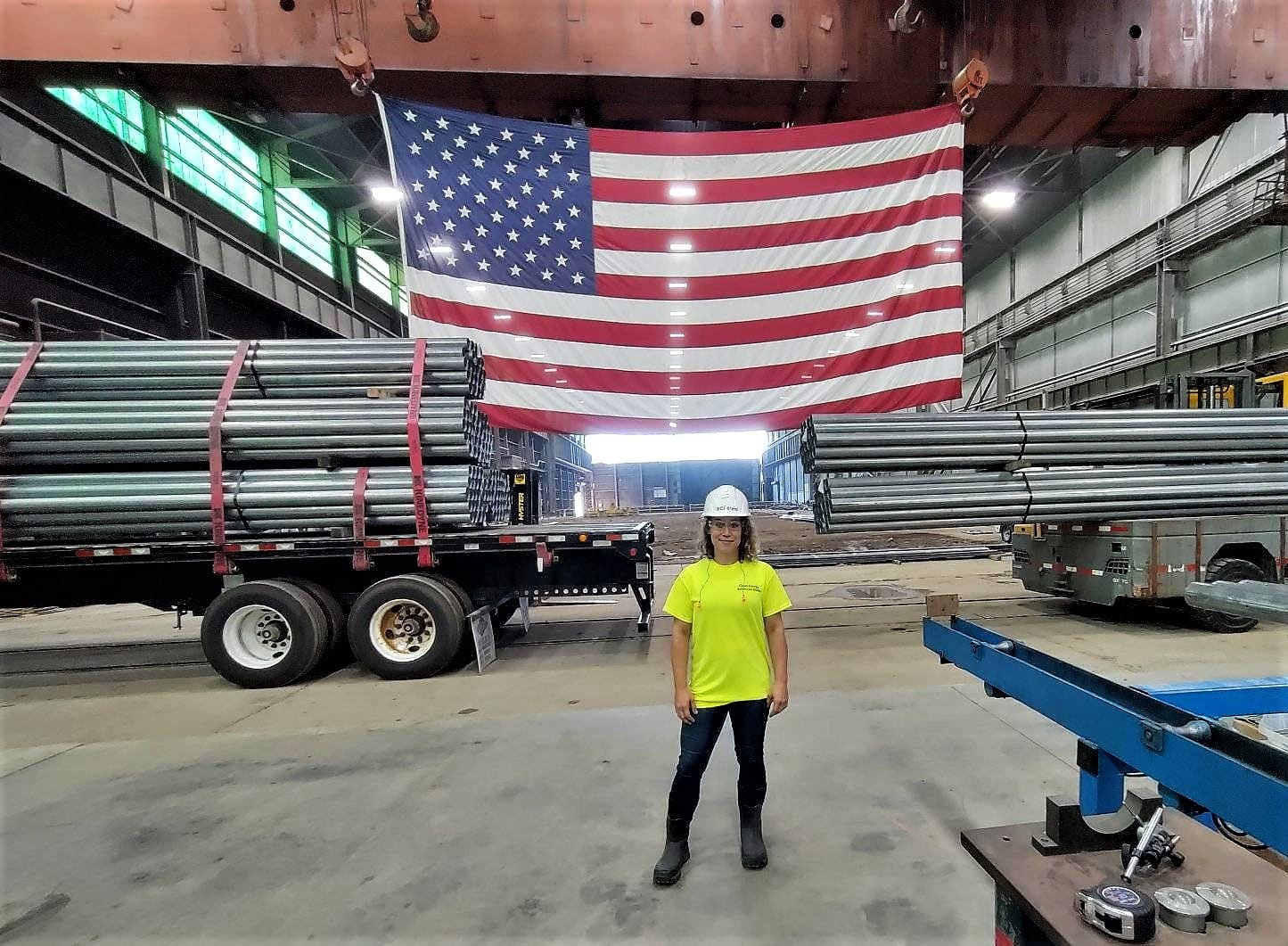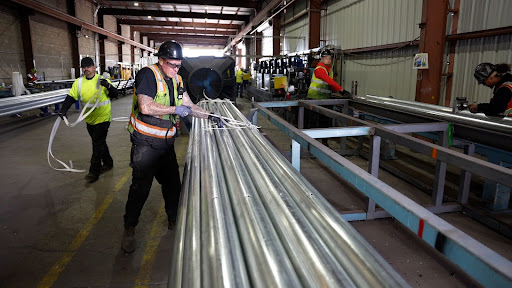Solar trackers are an important part of the renewable power puzzle. They enable photovoltaic (PV) panels to move in line with the sun, maximizing energy production throughout the day.
Essentially, the narrower the angle of incidence — or the angle at which the sun’s rays hit the PV panel’s surface — the more energy is produced, making trackers an attractive feature for large commercial projects. In 2022, Wood Mackenzie estimated that by the end of the decade, the global market for solar tracking would cumulatively represent a $71 billion opportunity.
Nextracker is one of the leading producers of solar trackers. The company has produced more than 100 gigawatts (GW) of them, equating annually to 18 million homes powered, 138 million carbon emissions avoided, 30 coal plants decommissioned, or 30 million cars taken off the roads. The company’s products are also designed to be good for the planet and its people.
Its NX Horizon solar tracker system comes with a low-carbon option made from recycled steel in an electric arc furnace that is the industry’s first to feature a 35% reduced carbon footprint.
There is also an all-terrain option that is amenable to uneven or sloping terrain, minimizes soil and local biodiversity disturbance, uses less steel in the foundation, and supports agrivoltaic applications that engage with and generate additional revenue for local farmers.

Photo Courtesy Nextracker
The company’s software services are also top-tier. TrueCapture™ maximizes solar power production through sensors and machine learning. Meanwhile, NX Navigator ensures tracker equipment availability, health, and weather risk mitigation through remote monitoring.
Nextracker’s Leadership
Before finding such extraordinary success with Nextracker, Dan Shugar (or “Shug”), founder and CEO, started his career at Pacific Gas and Electric Company. He made his name working on a United States Department of Energy (DOE) national research project about the value of solar for the grid, which eventually led to the rise of net metering.
He then went on to serve as president of PowerLight Corporation, which built the first 10-megawatt (MW) solar project in the world in 2004, and SunPower.
Since then, he has continued toppling milestones and educating the public about the importance of solar energy. His “Dinner with Dan” video series prepares you for family meals with your versions of his fictional character, “Uncle Bob,” who claims solar is a bad idea for several outlandish reasons that he debunks video by video. This past December, Nextracker celebrated a decade since its birth.
Video Courtesy Nextracker LLC
The man, who has been called “the King Midas of solar” for his ability to turn solar companies into gold, is also a talented musician. That love started when his father bought his first guitar at age 16 and flourished over the years into bands like Groovity and The Interconnectors, which have been huge attractions at the annual Solar Battle of the Bands.
“For me, having a great company is really like having a band — there’s a direct analogy,” Shugar explained to Aurora Solar. “Because you want to give every person space to contribute, and you want to be really listening to what’s happening. I think the thing that works most in our band is that everyone’s really carefully listening.”
“That allows a fundamental structure but a high degree of improvisation that happens live, adapting as you go,” he continued. “When it’s time to say something, you say it, but then you pull back and let other people contribute, and that makes the band — or company — that much more powerful. And it keeps it really interesting.”
Video Courtesy Dan Shugar
Nextracker’s Newest Factories
In June, Nextracker and manufacturing and supply chain solutions company Unimacts announced a new factory in Sloan, Nevada, near Las Vegas. The 160,000-square-foot factory will make steel torque tubes that will support and rotate PV panels.
This effort is the second collaboration between Nextracker and Unimacts in Nevada over the course of this year.
Last September, the two companies announced their first Nextracker-dedicated and Unimacts-owned and -operated manufacturing plant in Las Vegas.
That plant produces steel parts for Nextracker to incorporate into its ground-mount solar power generation facilities, funneling products across the Southwest.

Photo Courtesy Nextracker
The 2023 collaboration marked the 15th plant that Nextracker has opened or expanded in the U.S. since 2022, and this year’s facility marks more than 20 since 2021. The 2023 factory immediately added more than 100 jobs, with 125 now supported across both facilities.
According to American Clean Power’s estimation of total workforce additions generated by the Inflation Reduction Act, this is one of many drops in a larger bucket. The organization expects 550,000 new clean energy jobs to be created domestically due to the legislation, bringing the number of American jobs in the industry up to almost 1 million.
Moreover, the two Nextracker-Unimacts facilities will together support more than 2 GW of new solar power annually — the same amount needed to provide power for 400,000 residences.
Plus, with the latest plant, the company’s domestic solar tracker capacity has soared to more than 30 GW annually.
Nextracker and Unimacts have held dedication events for both announcements. 2023’s event, which overlapped with the solar industry show RE+ in Vegas, featured appearances from David Crane, the DOE’s undersecretary for infrastructure, and Abigail Ross Hopper, the president and CEO of the Solar Energy Industries Association (SEIA).
The 2024 event included Dwayne McClinton, director of the Energy Office at the Nevada Governor’s Office; Whitney Muse, senior policy advisor in the Office of Clean Energy Innovation and Implementation (OCEII) at the White House; and Jason Grumet, CEO of American Clean Power (ACP). Nextracker is a member of ACP, of which Shugar is also on the board of directors.
“Today’s announcement is a great example of clean power driving an American manufacturing renaissance in Nevada and across the United States,” Grumet expressed in the press release.
“Creating and expanding supply chains here at home strengthens America’s energy security, creates good-paying jobs, and boosts the economy. These new manufacturing facilities also exemplify the key role of American technology in creating a clean, reliable, and affordable grid.”
A History Of Nextracker
With a reshoring initiative and promise that all products produced for Nextracker will be “Made in the USA,” Nextracker’s production lines, so far, appear in states including Texas, Arizona, Pennsylvania, Illinois, Tennessee, and, of course, Nevada. As Shugar told Renewable Energy World’s “Factor This!” podcast, the leadership decided to ramp up domestic manufacturing in 2021 in the face of rising prices and longer delivery estimates for steel due to the COVID-19 pandemic:
“We decided right then that we were going to order a massive amount of manufacturing equipment to be able to support a significant expansion in key markets. … We are going to invest in the States,” he said. “We’re going to source U.S. steel. We’re going to get lower-carbon steel. And we’re going to hit high on-time delivery metrics. Full stop.”
In April 2022, a new solar tracker component manufacturing line, in collaboration with JM Steel, launched at a 97,000-square-foot Steel Dynamics, Inc. plant in Sinton, Texas.
It was estimated to provide 50 direct local jobs. That May saw the addition of a Nextracker-dedicated line producing steel tracker components in collaboration with Atkore at the electrical, safety, and infrastructure solutions company’s expanded facility in Phoenix.

Photo Courtesy Nextracker
In June, Nextracker collaborated with BCI Steel to renovate an abandoned steel factory in Pittsburgh. The plant had been used to make steel parts for amphibious landing ships in World War II. This past April, the company announced an expanded solar tube Nextracker-dedicated manufacturing lines at that facility, which more than doubled its production capacity to 4 GW.
As Shugar expressed in a blog post, investing in domestic manufacturing is also an opportunity to get rural community members on board with the oncoming wave of renewable energy that is as necessary as it is unstoppable.
“What if bringing factory work and energy security back to America is something we could meaningfully share with rural Americans as they consider whether to host renewable energy production in their communities?” he mused. He also shared the story of Michelle Barszcz, a lead line operator at Nextracker’s partner, BCI Steel’s tube mill near Pittsburgh, whose grandfather worked in the same building when she was a child.

Photo Courtesy Nextracker
While 2022 was extremely busy, the following year gave it a run for its money. In May 2023, MSS Steel Tubes USA started turning low-carbon steel into torque tubes for Nextracker at a new factory in Memphis, Tennessee, creating 129 jobs. In August, Asteelflash Group dedicated a line to producing self-powered controllers and high-voltage power supplies for Nextracker at its 197,000-square-foot plant in Fremont, California. The September opening of the Las Vegas facility with Unimacts followed swiftly on its heels.
Also, in 2023, the company went public in a $638 million IPO that brought the company’s valuation up to $3.5 billion, and this year saw it split from Flex, which acquired it in 2015.
This development starkly contrasted other energy companies like Energy Vault, Heliogen, and QuantumScape, which all went public by merging with special-purpose acquisition companies.
Going public “has given investors an opportunity to participate in a moment of seismic change in the way power is produced. I’ll put the scale of this in context through our own experience,” Shugar broke it down for Bloomberg. “Last fiscal year, we shipped about 350 megawatts a week. That’s adding about the same power-generating capacity as a small coal plant, every week, or four square miles of power-producing equipment, every week for the whole year. And demand is only going up.”

Photo Courtesy Nextracker





